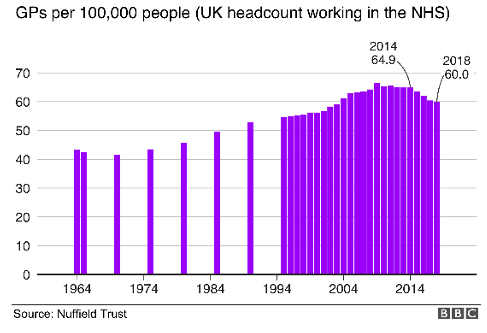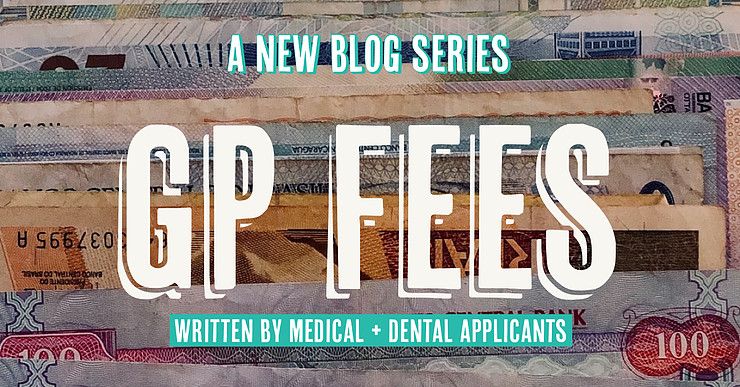A guest blog written by Harjeet S. Wilkhu, Year 12
Time and time again, we are told that our NHS is in severe distress. Whether it be through a headline on the BBC, or a post on mainstream media, the message drilled into us is that our NHS is doomed to fail without substantial investment. The NHS needs money, and needs it now. One way to do this is to make people pay to see their GPs. However, there is no point in doing so if there aren’t enough GPs available, but it is clear that the NHS is drowning under a sea of patients and unachievable targets. Paying for GP appointments is, at the very least, looking like a financially viable way forward.
There is a huge shortage of GPs. In 2016, NHS England set a target of adding 5000 general practitioners by 2020. However, no data was given to show that this would be enough to meet demand, and a report from Imperial College London suggested this was a substantial under - estimation. Research presented at the RCGP[1] 2016 Annual Conference concluded that the NHS was already 6,500 GPs short, rising to 12,100 this year. Between 2013 and 2017, a total of 445 GP practices had to close, leaving millions of patients to find other practices further and further from their homes.

According to official figures, there were just over 28,000 fully qualified full-time equivalent GPs in England as of September 2019. This is a drop of 3.7% since September 2015.
An analysis by the Nuffield Trust showed that the number of GPs per 100,000 people had fallen from nearly 64.9 in 2014 to 60 last year.
These are daunting statistics, especially given the increasing, ageing population. As a result, the average doctor now has 125 more patients to look after than they did 6 years ago. In essence, GPs are being asked to work longer and harder, with no increase in pay. Dr Richard Vautrey, of the BMA, said workloads were now "unmanageable" for many.
According to an article on the King’s Fund website[2], there are up to 350 to 450 million visits a year to GPs. If there was a charge of £10 per appointment, £3.5bn - £4.5bn could be raised. According to John Appleby[3], this “would pay for all day-case treatments or around half the total community prescriptions bill every year”, and there would still be money left over. The NHS has charged for prescriptions and dental care for years, and the added charge of GP appointments may encourage patients to take more personal responsibility, leading to fewer people attending with conditions that they could manage themselves or that would be better managed through other services such as nurses and physiotherapists. Thus, there is a valid argument in favour of paying to see GPs.
Consequently, the central principles of our NHS are that it:
· Meets the needs of everyone
· Be free at the point of delivery
· Be based on clinical need, NOT ability to pay
By paying to see our GPs, is it not a complete abnegation of all these principles? By charging people, whether it be £10 or £100, GP appointments would not be free at the point of delivery. Thus, it would not be able to meet the needs of everyone. Some people will still not be able to afford the fee and so the NHS would not be accessible to those who need it. There is the possibility of excluding certain vulnerable groups (children, elderly, etc.) from paying. However, if we were to base this on exclusions for prescription[4], just under 90% of prescriptions are dispensed free of charge. Apply this to the GP payment model, and the total income is substantially reduced to around £350 to £450 million a year. This is still a rather large amount of money, but nothing compared to the £3.5bn - £4.5bn which could be received. This still does not include the administration costs of collecting the charge. This is simply not sufficient enough to introduce the proposition.
There is then the possibility that despite exclusions, some people will be deterred from visiting their GP when they have a medical condition that needs attention. They would subsequently be needing more costly treatment, putting further economical strain on the NHS; strain it may not be able to handle.
To conclude, even with the ever – increasing burden on the NHS, we should not have to pay to see our GPs. To say that the NHS is in debt is an understatement, yet just the other day, the Health Secretary Matt Hancock wrote off £13.4bn of historic NHS debt. This is one step towards the recovery of our healthcare service, but there is still a long way to go. Making patients pay to see their GP may dissuade some whose conditions are trivial, self-limiting or easy to treat by themselves or other professionals (i.e. physiotherapists), but if just 4% decided not to seek care, then there is total of 1.7 million people deciding not to seek care. This cannot be allowed to happen. Having to pay to see a GP is a step back, rather than a step forward. Finally, if funding the NHS is the aim of paying to see a GP, it is worth remembering that we already fund the NHS through general taxation and National Insurance. Can the public afford extra charges?[5]
[1] Royal College of General Practitioners
[2] https://www.kingsfund.org.uk/reports/thenhsif/what-if-people-were-to-pay-10-to-see-a-gp/
[3] John Appleby is Director of Research and Chief Economist at the Nuffield Trust. He is a visiting professor in the Department of Economics, City University, and a visiting professor at the Institute of Global Health Innovation, Imperial College. Quote taken from The King’s Fund website: https://www.kingsfund.org.uk/reports/thenhsif/what-if-people-were-to-pay-10-to-see-a-gp/
[4] A valid presumption. Prescription charges are £9.00 per item. The GP payment model is £10 per appointment. Bearing in mind some patients need more than 1 item, the calculations will likely be at the most, slight under-estimations.
[5] Probably not, especially due to the heavy economical impacts of the coronavirus pandemic.
